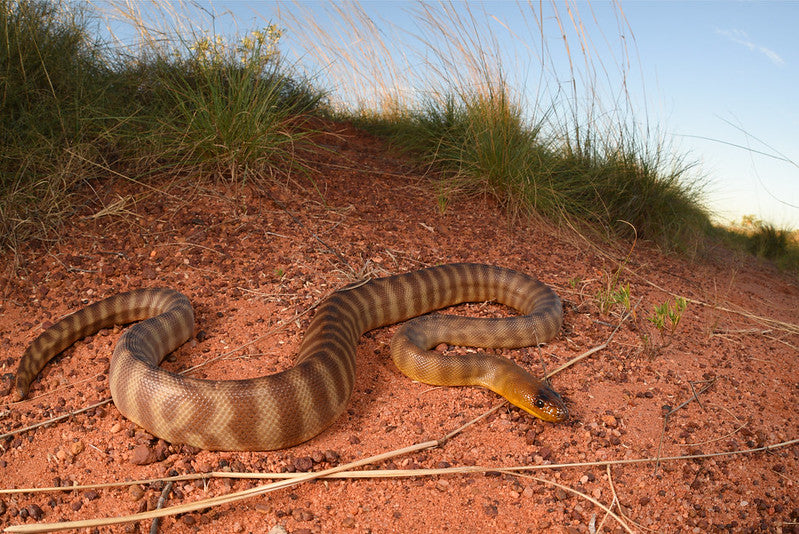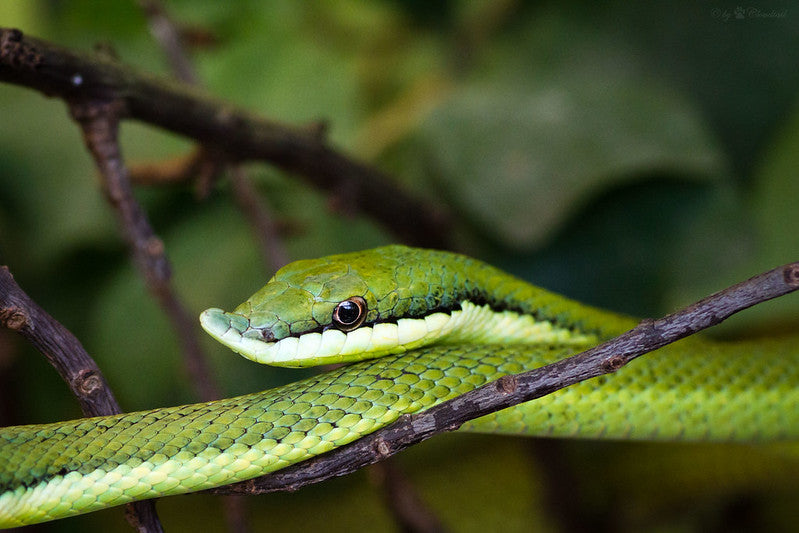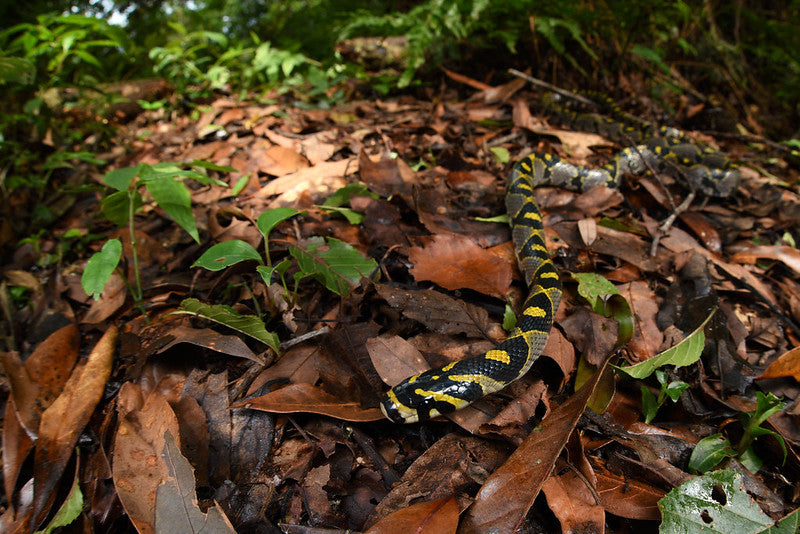The woma python (Aspidites ramsayi) is also known as the sand python or Ramsay’s python. They’re a medium-sized, terrestrial, nocturnal snake found in central and western Australia. They prefer arid to semi-arid, sandy habitats with sparse vegetation, and spend most of their time in burrows.
Woma pythons are typically around 5’ long, although southern localities are known to be able to grow up to 8’ long. They have smooth scales, an oval head, and black eyes. Base color is typically cream to tan, with indistinct olive to reddish brown bands down the length of the body. The head is generally yellow-brown to orangish and unmarked in adults, although young individuals have a dark patch over the eyes which may be slightly retained with age. Older individuals may have faded banding or no banding at all.
Woma pythons are an intermediate-level pet snake and very enthusiastic about food. With good care, they can live 15-20 years.
How much space do woma pythons need?
Although woma pythons are nocturnal, which means that they do most of their roaming when you’re not awake to watch, they’re still considered fairly active snakes, and it’s important to keep that in mind when housing them. The average adult woma python should be housed in no smaller than a 6’L x 2’W x 2’H enclosure (or equivalent) in order to allow the snake to stretch out to its full length, thermoregulate effectively, and move around as desired. This is just the minimum, so using larger dimensions is beneficial and will happily be used!
Due to cannibalism risk, cohabitation (keeping multiple woma pythons in one enclosure) is not recommended.
Do woma pythons need UVB?
They can survive without it, but it’s still best practice to provide UVB lighting for optimal health and wellbeing. UVB gives snakes all of the vitamin D that their bodies need, stimulates better appetite and activity, and generally allows them to be healthier than they would be without.
To achieve a max basking UVI of 2.0-3.0, the best UVB bulbs for woma pythons are:
- Zoo Med T5 HO Reptisun 5.0, 22”
- Arcadia Forest 6%, 22”
The UVB bulb should be roughly half the length of the enclosure, housed in an Arcadia or Vivarium Electronics reflective fixture, and placed close to the heat lamp on top of the enclosure or with a mesh cover, 10-13” above the basking surface. UVB is blocked by glass and plastic, so you can’t give your snake UVB by placing its terrarium in front of an open window. Also make sure that the fixture your UVB bulb is in does not have a clear plastic bulb cover.
Lights should be on for 13-14 hours/day during summer and 10-11 hours/day during winter. Alternatively, you can use a smart timer to sync the lamps with local sunrise and sunset times. This helps encourage more natural hormonal rhythms and better long-term health.
What basking temperatures do woma pythons need?
Like other reptiles, woma pythons are ectotherms, which means that they need a temperature gradient in their enclosure to help them regulate their metabolism and stay healthy.
Woma pythons should have a basking temperature of 90°F. On the other side of the enclosure, the temperature should remain between 82-86°F. Track the temperatures in your enclosure with two digital probe thermometers. Heat sources should be turned off at night. Nighttime temperatures should be kept above 75°F. During winter fasting, the heat source can be turned off.
Provide heat for your snake by imitating the sun with at least two 60-75w incandescent heat lamps placed on one side of the enclosure, positioned over a flat basking stone and warm hide. Do not use ceramic heat emitters (CHEs), red bulbs, or blue bulbs, as these are not as effective.
If the basking temperature is too high, use a rheostat or proportional thermostat to dim the heat lamps. If the basking temperature is too low, increase the wattage of the heat lamps.
What humidity levels do woma pythons need?
Although woma pythons are native to a dry environment, they spend most of their time in burrows with humidity levels that are much higher than the surrounding air, and they’re primarily active at night, which also has higher humidity levels than during the day. Humidity levels should be between 50-70% at night, but occasional spikes higher are safe.
You can track your humidity levels with a digital probe hygrometer placed in the middle of the enclosure. Mist the enclosure in the evening with a pressure sprayer as needed.
It’s essential to provide a humid hideout in order to simulate the snake’s preferred burrow environment. To create a humid hideout/burrow for your snake, simply take a plastic or resin reptile hide and line it with moistened (not soaking wet) sphagnum moss, shredded paper towel, or substrate. Check for mold regularly.
What substrate is good for woma pythons?
Woma pythons need a substantial layer of substrate to cushion their bodies and make room for burrows. As an added perk, it also tends to make the enclosure more attractive! We recommend the following substrates for woma pythons:
- Zoo Med Repti Sand
- Exo Terra Desert Sand
- Exo Terra Riverbed Sand
Substrate should be at least 4” deep and completely replaced every 3-4 months. Remove poop and urates daily, along with contaminated substrate.
What décor can you use in a woma python terrarium?
It’s terribly boring for a snake to be stuck in an enclosure with nothing in it except substrate, hides, and a water bowl. It doesn’t matter how big the enclosure is if you don’t put things in it for your pet to use and interact with.
At minimum, three sides of the enclosure should be covered and there should be multiple hiding places available. However, it’s a good idea to add other forms of cover that your snake can climb around on, such as branches, cork flats, and well-secured stacks of flagstone.
What do woma pythons eat?
Like other snakes, woma pythons are carnivores, which means that they need to eat whole animal prey in order to get the nutrition that they need. Here is a basic feeding schedule based on snake age:
- Juveniles should be fed 1x/week.
- Adults should be fed every 2-3 weeks.
Prey items should be around 10% of your snake’s weight or no more than 1.5x its width. If the snake seems to be getting fat, reduce the frequency of feedings. Although live prey can be used, it’s safest and most humane to use frozen instead. Prey should be completely thawed in a plastic bag in warm water before offering with a pair of soft-tipped tweezers.
Remember, the key to great nutrition is variety! Woma pythons eat a varied diet in the wild of reptiles, birds, and small mammals. Aside from offering mice and rats as feeders, try young hamsters, gerbils, quail, chicks, and feeder lizards/snakes.
Supplements
Woma pythons can survive without vitamin or mineral supplements, but occasionally using them can help prevent nutritional deficiencies and optimize your snake’s health. We recommend Repashy Calcium Plus LoD.
Water
Your snake should have access to clean, fresh water at all times. Provide a water bowl, but not large enough for soaking. Change the water daily and scrub the bowl with a reptile-safe disinfectant weekly, or whenever it becomes soiled.
Do woma pythons like to be handled?
Few reptiles actually “like” to be held, and woma pythons have a reputation for being pretty enthusiastic about food, which can make them a bit nippy, especially when young. That being said, this tendency can be mitigated with training. During handling, be gentle, and pick up the snake from below rather than from above. Support as much of its body as possible, and NEVER pick up a snake by its tail!
*This care sheet contains only very basic information. Although it’s a good introduction, please do further research with high-quality sources to obtain additional information on caring for this species.
"Woma python (Aspidites ramsayi)" by Wild for Wildlife is licensed under CC BY-NC-SA 2.0.




Leave a comment
This site is protected by hCaptcha and the hCaptcha Privacy Policy and Terms of Service apply.